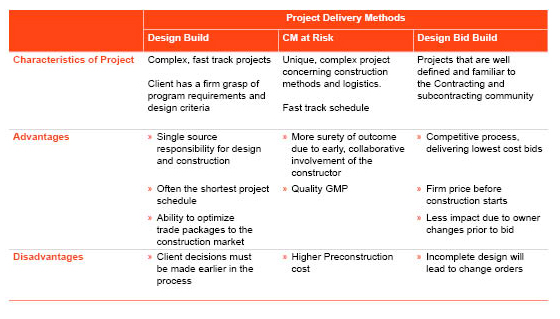Insights • October 26, 2017
Owner Engagement in Project Delivery
All capital projects are unique in some respect. Understanding your organization’s capabilities, characteristics of your project, and pros and cons of the three main delivery methods will assist owners in picking the best approach to achieving project goals. It is important to remember that every capital project must be planned, designed, procured, constructed, and closed out regardless of delivery method. Therefore the owner must remain engaged throughout project development to protect their interests. Delivery methods provide different arrangements of risks and responsibilities, with the best results occur when the entity most capable of managing risks are assigned those responsibilities.
The most common delivery methods available to project owners are – design/bid/build (DBB), construction management at risk (CMAR), and design/build (DB), each with its own benefits and risks. Let’s do a quick review of the delivery methods and the main characteristics of each.
Design-bid-build (DBB) is considered the traditional project delivery method where the project owner contracts with separate firms for the design and construction of their project. During the design phase the owner retains a designer to plan and design the project. The designer works with the owner to understand their needs, develop the design, and bring in engineering consultants to complete the construction plans and specifications. The bid phase occurs after design completion, where drawings and specifications are provided to general contractors who submit bids. Most often the project is awarded to the lowest price bidder, but some owners include other value based criteria beyond price. The architect or an independent Owner’s Representative will typically assist in the review of the bids and selection of the general contractor. Either the architect or owner’s representative will then act as the owner’s agent during the construction phase to review the progress of work and look out for the owners’ interests.
The Construction Management at Risk (CMAR) method involves hiring both a Construction Manager (CMAR) and designer at the beginning of the project. They provide pre-construction services in a consulting role during the design phase and perform as a general contractor during the construction phase. At some stage of design, the CMAR commits to deliver the project for a Guaranteed Maximum Price taking on cost and schedule risk if the project is not completed on time and within the GMP. At this stage, the owner and CMAR’s interests are aligned to achieve the project GMP and schedule.
Finally, the design/build (DB) delivery method establishes a contract with single entity to provide both design and construction. Procurement for design build may include selection based on the owner’s determination of best value, lowest cost, or a combination of the both. This method delivers the project under one contract and streamlines delivery by allowing construction to proceed earlier as the design progresses. The DB entity handles the construction procurement and management services, delivering a complete project to the Owner.
To choose the best delivery method for your project, you need to fully develop your goals and priorities, while being honest about your internal capabilities to develop a project. Each method offers benefits and risks.
Here are some things to consider with each delivery method.
Design Bid Build
If your schedule can support the extra time for distinct design, bid, and construction phases, DBB gives the owner a chance to look at a complete design before construction begins and provides more certainty of cost on bid day. Areas of concern would be that if your design is not complete or of poor quality you run the risk of additional change order cost and project delays. In addition if you award the construction on low bid basis, you may be saddled with a contractor who struggles to perform the work. Pre-qualification of bidders can lessen this risk.
Construction Management at Risk
CMAR should provide valuable pre-construction services and advice as your project team collaboratively develops a design that meets budget and schedule. This method also provides a GMP at some point during the design phase and a shorter schedule as the design, procurement, and construction phases overlap. Owners should realize that CMAR often adds 1% to 3% to the upfront cost of the project, which can be offset with a successfully implemented project. Owners need to ensure they select a CMAR whom they trust and share a common project vision. The owner may want to get independent advice on the buildup of the GMP to ensure complete understanding of how risks and responsibilities are addressed.
Design Build
DB typically offers the shortest schedule for project implementation affording great opportunity to overlap the design, procurement, and construction phases. There may also be efficiencies that provide cost savings. From the owner’s perspective there are less procurement and financial transactions since most of the work resides with the single DB entity. DB is not particularly well suited to project where the owner does not have a firm grasp on what they want. Program revisions, changes in materials and level of quality, and additional scope features added to the project after award, tend to take away the cost and schedule advantages of DB.
The chart below outlines the three delivery methods and the characteristics of projects best suited for each.

These are all viable delivery methods and if you engage experienced designers and contractors, with a collaborative approach, you can have good results with any approach. The most successful projects start with a strong plan and have an owner who stays engaged effectively throughout project development and construction.
